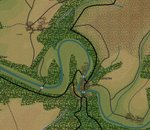
In a nutshell, here's what happened at Marvie:
Striking at Bastogne through Marvie was the mission given to KG Hauser, which consisted of Pz Lehr's 901 Pz Gren Regiment and the Pz IVs of the 6/130 Pz Coy. They attacked the hamlet on the evening of December 23rd, the night affording some protection from the Allied fighter bombers that ruled the skies in daytime.
Marvie was held by Team O'Hara, defending the NW corner with help from the 609th TD Bn and the 2d Bn of the 327 Glider Inf Regiment, which was positioned along the south. These units had been shelled all day when the bombardment suddenly increased and was followed by an infantry rush on the the hill to the south, which overlooked the town. The glider infantry detachment was surrounded and destroyed.
A German half track, followed by four tanks from the 6/130 tried to exploit this victory and travel down the hill into the town, but the halftrack leading the group was knocked out and blocked the path of the tanks.
At this point, 12 more German Panzers and Infantry tried to force their way through on the Arlon-Bastogne road, which ran through the town, but these where beaten before they reached the town.
After midnight, the Germans renewed their attack, and with an additional 15 Panzers supported by infantry, they were able to take the south half of Marvie. The cost to the Germans was 8 Panzers for the night's attack. The town lay divided as the morning light broke into the sky and it would remain that way for days to come.
To learn more about this battle, read Cole's chapter on Bastogne.


